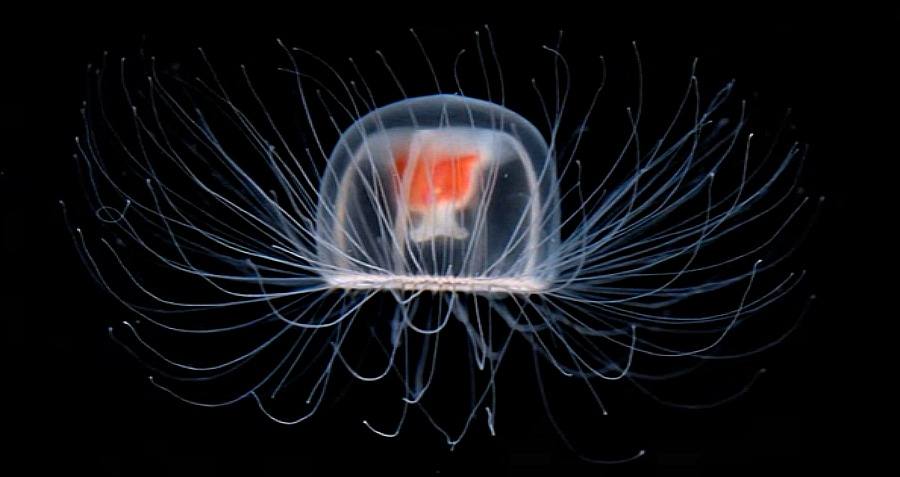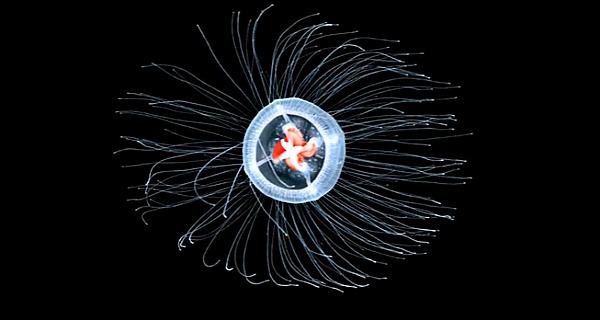Known as the immortal jellyfish, Turritopsis Dohrnii's can live forever — and scientists are working to see if they can apply its properties to humans.
A fountain of youth exists, and a tiny species of jellyfish can be found swimming around in its eternal waters.
Well, not exactly. An invertebrate capable of immortality does exist, but it doesn’t achieve endless life via its swimming location but instead through its unique biological make-up.

Turritopsis dohrnii, the “immortal jellyfish”.RandomTV/YouTube
Found in the waters of both the Mediterranean Sea and Japan, a tiny invertebrate called Turritopsis dohrnii is the only animal known to be biologically capable of reverting back to sexual immaturity after reaching adulthood. As there is no limit to the number of times it reverts back to a near-infant state, it can conceivably repeat the process forever, rendering it immortal.
Formerly known as Turritopsis nutricula, scientists first discovered the immortal jellyfish in 1883, when they found it swimming in the warm waters of the Mediterranean.
But it would take another century for scientists to discover the species’ unique abilities — and to discover that the immortal jellyfish’s long life wasn’t some otherworldly blessing, but an attempt to save itself from the dangers of the deep sea.
The Process Of Achieving Immortality
So just how does one go about living forever?
If you’re thinking of these creatures as a thousands-of-years-old entity, you’re not technically wrong, but you’re not quite right, either. Turritopsis dohrnii, like any other type of jellyfish, starts out as larva developed from a fertilized egg to create what is known as a planula.
These free-swimming planula go off on their own, eventually settling on the ocean floor to create a colony of polyps, which grow upward from the seafloor to form a cylindrical shape. From these polyps, a medusa, or jellyfish, forms, which breaks off from the branch after reaching adulthood in a matter of weeks.

RandomTV/YouTube
Now fully grown to measure a whopping 4.5 mm — about the width of your pinky fingernail — the newly adult jellyfish is recognized by its bright red stomach, easily visible through a transparent, bell-shaped body lined with 90 tentacles around its edges.
This tiny being may not seem like much, but its singular survival skill allows it to adapt to various environmental threats, from physical harm to starvation.
For example, let’s say a Turritopsis faces a lack of food. Your average jellyfish would simply die of starvation, but not this one. Instead, the immortal jellyfish will attempt to get a “second chance” at life by reverting back to sexual immaturity.
On a cellular level, this means that the immortal jellyfish will effectively recycle its existing cells to form a new self in a process known as “transdifferentiation.” In terms of physical process, this means that the jellyfish will retract its tentacles and shrink its body, and then drop to the ocean floor. From there, the jellyfish regresses into a sexually immature larva and forms new polyps until it reaches adulthood once again.
As astounding as that process is, it doesn’t necessarily mean that the jellyfish is technically “immortal” in every sense of the word. For one, the Turritopsis can be killed — by a predator, for example.
Moreover, as James Carlton, a professor of marine sciences at Williams College, told The New York Times Magazine, “That word ‘immortal’ is distracting. If by ‘immortal’ you mean passing on your genes, then yes, it’s immortal. But those are not the same cells anymore. The cells are immortal, but not necessarily the organism itself.”
Nevertheless, the immortal jellyfish is surely an incredible creature and one whose abilities might just have some use for humankind.
What Does The Immortal Jellyfish Mean For Science?

Ian Gavan/Getty ImagesJapanese scientist Shin Kubota, one of the leading researchers in the field, presents a container with several immortal jellyfish in Venice, Italy on September 4, 2016.
In addition to its incredible survival skills, the Turritopsis dohrnii is also known for catching rides on large cargo ships to reach new waters far from home. In part because these tiny hitchhikers are popping up in warm waters all over the world, they have caught the attention of the scientific community once again, this time inspiring those focused on stem cell research.
Transdifferentiation is especially exciting for researchers as it doesn’t require a stem cell to form a new cellular makeup. As the non-stem cells found within each jellyfish can become practically any other type of cell through this process, scientists and researchers are looking to this biological marvel for clues on how to regenerate damaged human tissue to treat a wide variety of medical ailments.
Taking cues from Mother Nature herself, the scientific community is looking to the Turritopsis dohrnii for new ways to manipulate cells.
In fact, one recent study of mice found success in using gene manipulation to get fibroblasts, a type of architectural cell in the heart, to transdifferentiate into cardiomyocyte-like cells, the essential bundles of muscle that allow the heart to do its job.
While researchers still have a long way to go in understanding just how the process which puts the “immortal” in “immortal jellyfish” can work to benefit humans, big strides are being made one step at a time.
Fascinated by this look at Turritopsis dohrnii, the immortal jellyfish? Next, check out our compendium of jellyfish facts. Then, have a look at seven of the most frighteningly bizarre ocean creatures.





